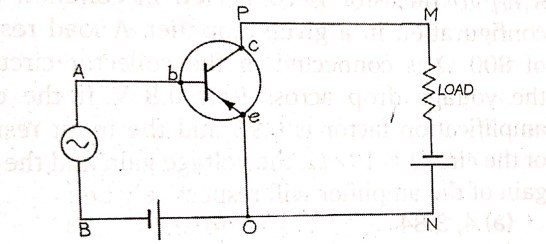Q1
What is an n-p-n transistor? Give its symbol and describe its working. Why is it more useful in
comparison to p-n-p transistor?
Solution










Q2
Describe briefly, with the help of a diagram, an n-p-n or p-n-p transistor. Define current gain for a
transistor.
Solution






Q3
Draw a labelled circuit diagram of an n-p-n transistor in a common-emitter configuration to study its
characteristics.
Solution




Q4
Drawing a labelled circuit diagram, explain how a p-n-p transistor can be used as an amplifier in
common-emitter configuration? Derive expression for its voltage-gain.
Solution


Q5
Draw a labelled circuit diagram of common-emitter type transistor (n-p-n or p-n-p) amplifier showing the
biasing correctly
Solution


Q6
Draw a labelled diagram of common emitter amplifier,
showing waveforms of signal voltage and ourut voltage.
Solution


Q7
Draw a circuit diagram for the common. transistor amplifier. What is meant by phase reversal?
Solution


Q8
With proper labelling of the axes, draw the input and output characteristic curves of n-p-n transistor
in
common-emitter configuration.
Solution




Q9
Draw a labelled circuit diagram of a simple common- emitter amplifier. What is the phase angle between
the input and output voltages?
Solution


Q10
Figure below shows the circuit of an electronic device:

(i) Which electronic device: a rectifier, an amplifier or an oscillator does the circuit represent?
(ii) State where the input voltage is applied and where the output voltage is available.
(iii) Compare the output voltage of this circuit with its input voltage. Solution

(i) Which electronic device: a rectifier, an amplifier or an oscillator does the circuit represent?
(ii) State where the input voltage is applied and where the output voltage is available.
(iii) Compare the output voltage of this circuit with its input voltage. Solution

Q11
What is an n-p-n transistor? Give its symbol and describe its working. Why is it more useful in
comparison to p-n-p transistor?
Solution









